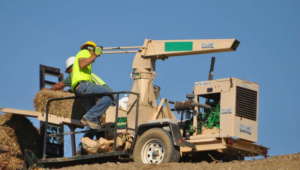What is Erosion Control?
 Generally speaking, erosion control is a process planting seed to establish temporary or permanent vegetation to mitigate erosion. Erosion is a process where rain runoff causes soil to be carried away. Generally it’s a natural process that takes place slowly over time.
Generally speaking, erosion control is a process planting seed to establish temporary or permanent vegetation to mitigate erosion. Erosion is a process where rain runoff causes soil to be carried away. Generally it’s a natural process that takes place slowly over time.
This practice applies to areas of exposed soil where the establishment of vegetation is desired. Temporary seeding applies to disturbed areas that will not be brought to final grade or on which land-disturbing activities will not be performed for a period greater than 30 days, and requires vegetative cover for less than one year. Permanent seeding applies to areas where perennial vegetative cover is needed.
Complete Site Solutions has the equipment and experience to implement the required control measures and maintenance for any of your projects. Our guidelines for developing and implementing erosion and sediment control plans for your site:
Erosion Control Measures
Complete Site Solutions recommends the following onsite erosion control measures (remember the underlying concept is to vegetate / cover bare soils):
- Limit vegetation removal to the extent possible
- Seed bare soils and cover with 2”-4” of straw
- Place erosion control blankets on slopes
Sediment Control Measures
Complete Site Solutions recommends the following onsite sediment control measures (remember the underlying concept is to capture sediment that was not controlled by the measures listed above):
- Straw Rolls (also called fiber rolls, coir rolls, or wattles) – Straw rolls can be used on slopes, at the bottom of slopes or around drainage devices (such as catch basins).
- Silt Fence – Silt fences are generally used at the bottom of slopes as a means to capture sediment. They should never be used on slopes and are not really effective as protection around storm drains.
- Gravel Bags – Gravel bags are essentially sand bags filled with drain rock rather than sand. They can be an effective way to protect storm drain inlets. Filling the bags with drain rock rather than sand allows water to filter through without creating a dam.
- Rocked Construction Entrance and Rocked Access Areas – Rocked construction entrances are used to keep sediment from being tracked onto adjacent roads. They are generally 30’-50’ long, 12’ wide and consist of large rock (3”-6”).
Rocked access areas should be used to keep construction vehicles off of bare soils.
Runoff (Drainage) Control Measures
Complete Site Solutions recommends the following for controlling runoff on your site.
- Disperse Drainage in Vegetated Areas – Vegetated areas are generally less erosive than areas with bare soils. Where possible try to capture or divert runoff to avoid newly disturbed areas.
- Disperse Drainage in Numerous Locations – Development of parcels changes pre-development runoff patterns. One of the worst things you can do is to concentrate all of your drainage to one location. When sites are developed, rainwater is captured and / or diverted to areas that are different from before construction began. Therefore areas of the site may see more runoff after construction than the soil is accustomed to and increased erosion may be the result.
- Keep drainage away from fill slopes – Fill slopes are generally more erosive than cut slopes. Concentrated runoff should never be allowed to flow over a fill slope. If there is no other option, try to break up drainage so it sheet flows over the fill slope.
- Use water bars, rolling dips or curbs to breakup drainage along roads or driveways – Water bars are basically speed bumps (4”-6” in height) made with soil or baserock that are placed across the driveway at an angle to direct drainage. Rolling dips are shallow swales that are cut across the driveway.
- Install Energy Dissipators – An energy dissipator is a structure designed to control erosion at the outlet of a pipe, conduit or channel by reducing the velocity of flow and dissipating the energy. Outlet protection helps to prevent scour and to minimize the potential for downstream erosion.
Maintenance
Complete Site Solutions recommends the following for maintenance of your erosion, sediment and runoff control measures on your site.
- Check on the performance of what you installed whiles it’s raining
- Keep extra supplies on hand – It’s a good idea to keep some extra seed, straw rolls, silt fence and erosion control blankets in a dry location.
- Remove silt that has built up behind straw rolls and silt fencing, as well as around drainage inlets.


